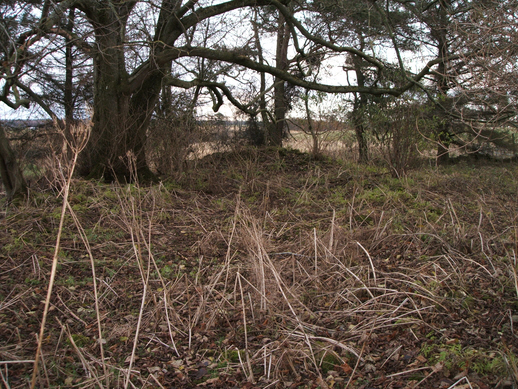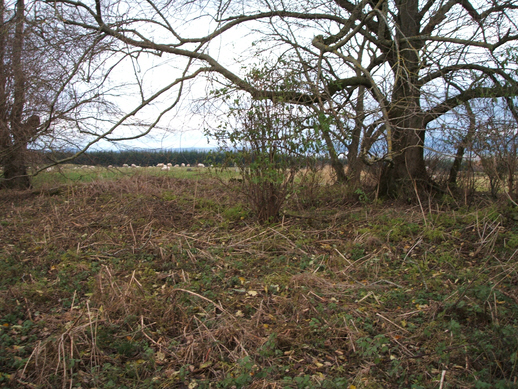Inverness Deanery
Dalcross
Parish Church: OS Ref: NGR NH 775485 H.E.S. No: NH74NE 18 Dedication: (unknown)
Associated Chapels: Milton of Clava {NGR NH 752439}; Galcantray {NG NH 810483}; Chapelton {NGR NH 732464}; Cill Dhuaich {NGR NH }.
Dail an Ròis 'Field of the Rose'. This may be a botanical reference but it is as likely to signify a link with the family of Rose who were so powerful in this area in the early medieval period.
There is no doubt that there has been a church at Little Dalcross from at least the 12th-century and, although some writers consider it to have been only a chaplainry, there is equally no doubt that it was a Parish Church and an extensive one at that.1 The parish seems to have first shared its boundaries with the ancient Barony of Kerdale. This Barony was held by the Douglas family from at least 1206 and it is possible that the lands had originally belonged to the bishopric of Moray since it was an uncle(?) of Bishop Brice de Douglas (1203-1222) who was first recorded as 'de Kerdale'.2 The caput of this barony, the Castle of Kerdale, was situated in the dabhach of Daltullich, probably somewhere close to Castletown {NGR NH 749428}.3 Before the time of the bishops, this was royal land and it is because of this that, when the King founded the Priory of Urquhard c.1236, the church of Dalcross was annexed to it and so the Prior became responsible for providing a vicar to serve the 'cure'. Urquhard was also endowed with considerable properties at Kilravock, Geddes, and Penick. It should be noted here that the nearby lands of Duldauch {NGR NH 755435} (also known as Culdaach and Culdoich) were episcopal lands from very early times. This situation continued until the community at Urquhard moved and took over the priory of Pluscarden. Of course, Dalcross then became the responsibility of the Prior and the new community at Pluscarden. In later times the Barony of Dalcross became established within the old dabhach of the same name and a castle was built (c.1620) only a very short distance from the parish church.4
As a direct consequence of Dalcross' annexation to the Priory of Urquhard we have the instrument of 1343 which records that the then Prior agreed that the vicar who was installed at Dalcross would travel to Kilravock twice per week to say Mass in the chapel there and that the Prior would provide all that was necessary for this.13
Over time the parish gained certain additions (pendicles), some of which were at some distance from Dalcross itself. Notably, amongst these were the lands of the Leyis,5 extending to 3 dabhaichean - Easter Leyis, Mid Leyis and Wester Leyis. In 1449 these lands were noted as being part of Dalcross parish.6


Above: The ruins of Dalcross Church.
Milton of Clava: This church is said to have been one of the very earliest in Nairnshire. It is thought to have been a Columban foundation. Some writers have recorded that its dedication was to St Dorothea but this is most suspicious. If it is true, then it is the only church in Scotland to bear the name. We should remind ourselves that the Early Church did not 'dedicate' their churches - this was a habit brought in by the Roman influences of later times. It is also recorded as being known as St Bridget's Church7 which is more likely considering the popularity of that early saint across Scotland. At first sight this seems to be a strange place for one of the very earliest churches to be established. However, this section of the valley of the River Nairn was a very important and more direct route from the south and south-west to Ardersier. Here, there was passage across to Rosemarkie (another very ancient Christian site) and the lands to the far north. With the example of St Brendan the Navigator set before them, this passage would have presented no insurmountable difficulties for these early travellers. It is also worth considering here that there is a 'dedication' Cill Dhuaich 'Church of St Duthac (of Tain)' recorded in the parish.12 If this is accepted then it would support the idea of the glen being a routeway for the early Christian missionaries to Tain and further north. It would seem also to indicate where the names Dalduach, Culdoich and Culdaach are derived (see above).
Galcantray: Many years ago it was reported that a farmer, whilst reclaiming some of his land near Galcantray, discovered the remains of what was then considered to be an old chapel. In more recent times no traces of the supposed chapel have survived although there is a tradition of a graveyard here {NGR NH 810483}.8 In even more recent times Galcantray has been the cause of much excitement and specualtion amongst archaeologists. Excavations have revealed what, at first, appeared to be a Roman-period fortified enclosure. Although this work continued over a number of seasons the findings are still a matter of much debate. What were initially considered to be the remains of a winter camp for the Roman expeditionary forces are now assigned an uncertain date and some scholars argue that the remains are pre-Roman.9
Chapleton: A chalybeate spring, known in Gaelic as Tobar na Coille ('the well of the wood'), and in English as Culloden Well, or St Mary's Well, is situated in a birch wood above the mansion house of Culloden {NGR NH&nb;723452}. A circular stone building, paved with flagstones, encloses the spring. "The trees and shrubs all round are adorned with variously coloured rags, bits of thread and string. Names, initials and dates carved in all manner of styles defaced the trunks of most of the finest trees." St Mary's Well was so called from a pre-Reformation chapel dedicated to the Virgin, which stood near, but of which there are now no traces.10 There is, at Chapleton {NGR NH 732463} what may be the remains of this chapel - it is about one mile north-east of the Well and is recorded as being dedicated to St Mary.11
On 14 July 1618, the two parishes of Croy and Dalcross were united.12
Clergy:
1294 Malise, vicar of Dalcors (Dalcross) signs, as a witness, a charter of Archibald, Bishop of Moray, at the Episcopal Residence at Kineddar (30 October). [Reg. Epis. Mor., no.131, p.144]
1522 Magnus Vaus appears as vicar of Dalcross, (9 April). He was later (1536) vicar of Abertarff and died before 17 August 1542. [Fasti Eccl. Medii Aev., p.246]
1. At the annexation of Dalcross Church to Urquhard Priory the 'rectory' tithes were then paid to the monastery. This left the 'vicarage', or lesser tithes for the maintenance of a vicar who actually served the cure in the parish. If Dalcross had been only a chaplainry there would only have been an endowment sufficient for a vicar. This would have left nothing which could have been paid to the priory and there would, therefore, have been no point in such an annexation. The fact that there we only encounter 'Vicars of Dalcross' in the historical record has led some to believe that the church was only a chaplainry/vicarage. I can not remember a case in Scotland of an annexation to a monastery which did not involve the annexation of great tithes, or rectorial tithes of a parish church. The situation with regard to the annexation of lands or tithes for the support of chaplains in a cathedral or collegiate church is another matter entirely.
2. Some records shows that the parents of Bishop Bricius (Brice de Douglas) were William de Douglas, Lord of Douglasdale, and Margaret de Kerdal, whose brother, Freskin de Kerdal, was Bricius' uncle. The Barony of Kerdale and its Links with some Key Moray Families Freskyn de Kerdale was a patron of the church at Daviot, which was a mensal church of Bishop Bricius de Douglas. At the insistence of Freskyn de Kerdale the tithes of Daviot were granted for the fabric of the Cathedral Church when it was situated at Spynie.
3. Ross, A. (2003) The Province of Moray, c.1000-1230. Unpublished PhD thesis, University of Aberdeen. Vol.1, p.77.
4. It still stands to this day and is once more occupied. (see here.)
5. This estate is known as Leys today {NGR NH 68_41_} and lies about 5km south of Inverness. (These lands are not to be confused with the Deeside estate and barony of Leys, for generations possessed by the Burnett family.)
6. Ross, A. (2003) The Province of Moray, c.1000-1230. Unpublished PhD thesis, University of Aberdeen. Vol.1, p.77.
7. HES Canmore Database Milton of Clava NH74SE 7 accessed 8 July 2019.
8, HES Canmore Database Galcantray NH84NW 11 accessed 8 July 2019.
9. see Cawdor (Roman fort) for an introduction to the discussion.
10. Mackinlay, J.M. (1910) Ancient Church Dedications in Scotland: Volume 2. Scriptural Dedications. Glasgow: James Maclehose and Sons. p.118-9.
11. HES Canmore Database Chapleton, St Mary's Chapel NH74NW 7 accessed 8 July 2019.
12. Scott, H. (1918) Fasti Ecclesiae Scticanae. Edinburgh: Oliver & Boyd. Volume 6, p.440
13. (See notes for the Chapel of Kilravock, in Croy Parish.) Rose, H., Shaw, L., Innes, C. (ed.) (1848) The Family of Rose of Kilravock. Edinburgh: Spalding Club. p.117-8. Dated the first Wednesday after the Feast of St Andrew, (3 December), 1343.
e-mail: admin@cushnieent.com
© 2019 Cushnie Enterprises
